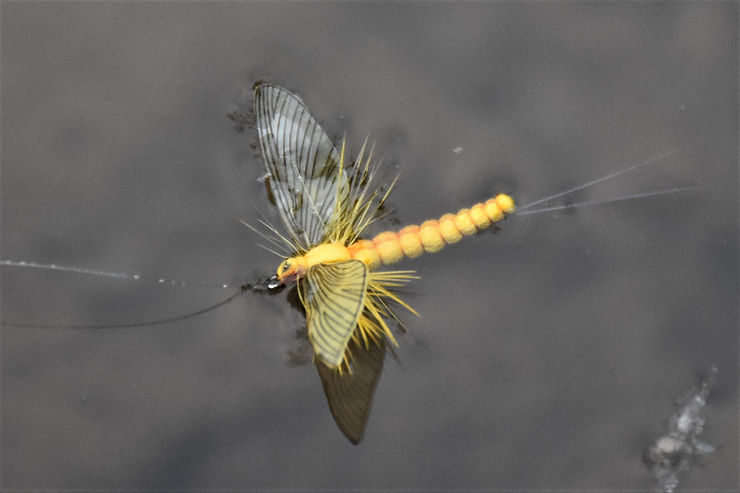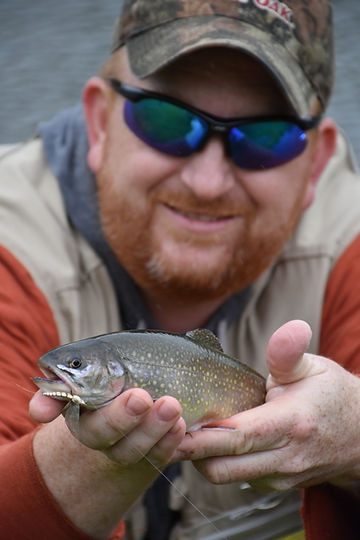J:Son Flies – Imitations Come to Life

When I tied on my first J:Son fly, I felt like I was tying on a real bug. Everything about them is realistic, from their body shape and proportion to their wing positioning and style. The detail in each fly makes it as much a work of art as it does a tool to catch trout.
It’s hard to be an innovator in a sport that’s hundreds of years old, but Swedish fly tyer Claes Johansson is indeed an innovator. Examine any J:Son fly closely and you’ll see that years of entomological study has translated quite well to the fly tying vise.
Johansson’s impetus for J:Son flies was to create realistic patterns that would float well and withstand some abuse. The foam on the dry fly and emerger patterns is a specially-produced micro closed-cell density foam that holds a lot of air no matter how thinly it’s sliced. The unique “burning” method used to create the wings (where two layers of material are actually fused together by burning the edges) leaves a small pocket of air within them, which also creates more buoyancy. The flies are tied with Dyneema thread, known in the U.S. as Spectra, which is only 50 denier yet incredibly strong and durable. In fact, their creator maintains that you can catch twenty or more fish with a single pattern without much signs of wear.
The stonefly imitations are some of my favorites. Unlike traditional stonefly patterns, the legs on these bugs are made of silicone which is impervious to UV light. They won’t fade or become brittle over time and will remain soft and supple. This suppleness adds to their effectiveness and results in fewer refusals compared to traditional, hard-legged patterns – they feel more natural in the fish’s mouth.
More than any of that, though, there’s another concept behind the flies that I find fascinating. They’re not too concerned about precisely matching every hatch in existence, and they’re not available in a huge array of colors. They’re more concerned with mimicking actual bugs than sizing, and the primary component of that is creating a profile that fish will identify as realistic. That’s where fly proportion enters the equation. In other words, if it looks like an insect on the water, and it’s in the ballpark as far as size and color, what else really matters?

I’m a natural skeptic of new products, and especially of the claims made by their manufacturers. I figured the best place to try out my assortment of J:Son flies was on one of my favorite Delayed Harvest Artificial Lures Only sections where trout see so much fishing pressure that they learn to spot a fake bug from the real thing very quickly.
To further challenge the merits of the flies, I chose a long, slow-moving pool that is perhaps the hardest-fished of all on the entire stream. Not only that, but the crawling current would give these hyper-educated fish plenty of time to analyze each offering.
When I arrived at the stream, there were bugs in the air and trout sipping naturals, but there weren’t enough of either to really get me excited. A guy across the stream from me, a chatty fella, said that he’d been having luck with a size 14 Gray Fox. By “luck” he meant that one fish had come up and pondered taking it in before finally refusing and another had struck the fly with an open mouth, a common occurrence on catch and release waters. You see them suck the fly in, but when you set the hook, all you get is air. The trout just aren’t convinced the fly is real enough to risk chomping down on it.
An assortment of Sulphurs, Light Cahills, Brown Drakes, and myriad caddisflies were in the air, but it was impossible to distinguish which, if any, the trout were feeding on. I tried a traditional Gray Fox pattern, then a size 16 Adams, then a Light Cahill, a Sulphur, and a Brown Drake, all to no avail. One spunky rainbow made a charge at the Brown Drake and then changed its mind last minute. After exhausting my options of traditional dry fly patterns, I opened my box of J:Son flies.
A few fish rose in front of me, although I couldn’t tell what they were feeding on. Either it was some sort of midge, or maybe tiny emergers, floating in the surface film. I settled on a number five black mayfly, which is the equivalent of about a traditional size 18 here in the U.S. Two casts later I landed a 14-inch rainbow. It came up for the fly, no hesitation, and sucked it right in.
Five minutes later, I caught an 11-inch brown. Not long after that, another rainbow. By then, light was fading and my eyes aren’t as good as they used to be, and squinting hard to see the little black fly was making my head hurt, so I switched to a bigger, brighter Sulphur imitation and picked up another brown.
When I went to my truck after that first experience with J:Son flies, the chatty fella from earlier asked how I did. I told him I’d caught four. He’d landed one. And from what I saw while observing the other half dozen guys on that stretch, we were the only guys to catch fish.

1) J:Son Flies are durable. I caught about a dozen fish over three evenings on that same little black mayfly pattern. Many of the patterns have withstood multiple catches. But I also have traditional ties that have caught a number of fish, too, and not every J:Son fly has turned out to be as durable as that black mayfly. I’ve had some last only one or two fish, especially if one of those fish was a toothy brown trout.
2) The construction of the flies makes them highly buoyant. So buoyant, in fact, that I’ve never had to apply floatant to any of the patterns. That’s a major plus.
3) The size and style of some of the mayflies cause them to helicopter quite a bit while casting, which results in a severely twisted tippet and leader. For that reason, J:Son flies created a swivel that can be used to attach the tippet to the leader. It’s highly effective and prevents twisting, although it’s a little bit of a pain to always have to remember to tie one on or keep a supply on hand at all times. On the other hand, these swivels are great for casting larger sizes of traditional patterns as well, such as grasshoppers, Humpies, Green Drakes, etc.
4) J:Son Flies are expensive, ranging from $3.49 to $4.29 from even huge discount distributors such as Percy’s Flies. Their durability could help offset their cost – more fish caught per fly – but it hurts a little bit when one ends up dangling from an unreachable tree branch.
5) The mayflies are tied with extended bodies and short-shanked hooks. Although they are wide-gap hooks, I still find myself missing and/or losing a lot of fish with J:Son flies. Sometimes I think the fish are simply nipping at the extended body and barely getting hooked, and then they easily shake off. Longer-shanked hooks might solve this, but they also might result in fewer takes anyway, so I guess it’s a wash and just something you have to accept. You’ll lose some fish with these flies, but in the end, you’ll also have more strikes.
6) The lack of color selection is a limiting factor for these flies. I’d like to see a greater variety of size and color to match the multitude of insects found in Pennsylvania streams. There were a number of times when, even though I got fairly close with the size and color, trout were still refusing it because it just didn’t match up close enough to what was hatching.
7) The grasshopper patterns are, hands down, the best I’ve ever used. They’re truly awesome. The Sulphur patterns are also fantastic, and when they’re on the water, they look more real than the real insect.
8) Are J:Son Flies worth purchasing? Yes. They’re realistic and effective patterns that work in a variety of situations.
Sign up for the Dark Skies Fly Fishing e-newsletter
It's free, delivered to your inbox approximately three times each month. Your information is always kept private and used for the sole purpose of keeping you up to date on blog posts and specials in the online store.
Sign Up Now